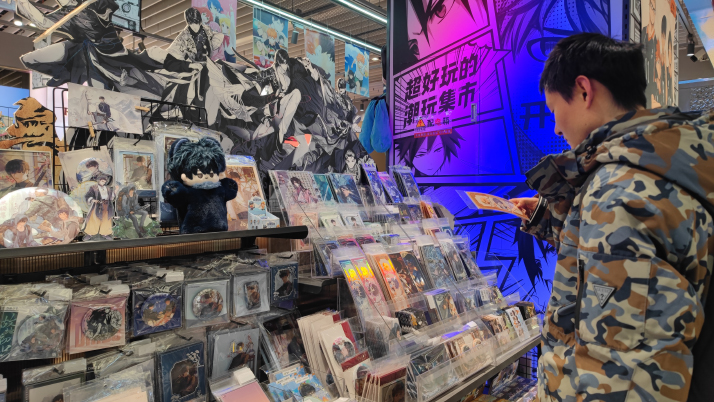| China |
| New symbols of joy and expression for China's youth | |
|
|
 A guzi store with anime-themed products at a mall in Beijing in December 2024 (LU YAN)
Wang Hui, mother of a high school student in Beijing, struggles to understand how a small metal and plastic badge featuring a "cartoon" character can cost more than a decent meal. However, for her daughter, this anime-related product, or guzi, is much more than what her mother just calls "a toy;" it represents a rare highlight in her otherwise stressful school life. In the realm of intellectual property (IP) goods related to animation, comics, games and novels (ACGN), guzi—a word derived from the English word "goods"—refers to merchandise derived from popular IPs in these genres. This trend caters to the young Chinese consumer palate, and especially that of Gen Z and Gen A (those born after 2010). The term guzi shares the same character as "grain" in Chinese, adding an interesting layer of meaning to its use in the context of merchandise. The act of purchasing guzi is often called chigu, which translates to "eating goods." This expression reflects the cultural significance of these items, portraying them as more than mere purchases. Just as grain is a staple of nourishment, guzi represents a source of joy and personal expression for fans, particularly within ACGN culture. "On weekends, my daughter often visits guzi stores in shopping malls and spends more than an hour browsing," Wang told Beijing Review. She noted that these outings cost her somewhere between 50 yuan and 200 yuan ($7 and $27) each week. "I allow this as a reward for her good school performance and as a way to help her relieve the pressure of heavy school workload." According to data from consultancy firm iiMedia Research, the market size of China's guzi economy surged to approximately 169 billion yuan ($23 billion) in 2024, up from 120 billion yuan ($16 billion) in 2023. This growth is expected to continue, with projections suggesting the market could exceed 309 billion yuan ($42 billion) by 2029. As the guzi economy flourishes, it reflects the evolving consumer preferences of younger generations while also underlining the broader cultural role of ACGN merchandise. For many, these products are symbols of expression, connection and identity in contemporary society. Market boom Guzi merch encompasses a wide range of items, including badges that star characters or logos from popular ACGN franchises, figurines of anime, comic or video game characters, small accessories like key chains or bag charms, and stationery products. Additionally, blind boxes—mystery boxes containing collectible items—are a popular part of the guzi market. The prices of guzi items vary widely depending on factors such as the type of products, their popularity and the brand. Typically, prices range from around 10 yuan ($1.36) for small items like badges or key chains, to several hundred yuan ($13.6 to $136) for more elaborate products like figurines or clothing. Limited edition guzi merchandise tends to be priced higher, with some highly sought-after items costing several thousand yuan (several hundred U.S. dollars). Data from Tianyancha, one of China's largest company databases, showed that the number of companies operating in the guzi industry grew by 14 percent between January and November 2024, bringing the total to 64,000, compared to the same period in 2023. Ma Yuanfang, an analyst at brokerage firm Zheshang Securities, believes the guzi economy has the potential for long-term growth. "More IPs will continue to evolve and expand... Additionally, marketing strategies and consumption scenarios will become more diverse and sophisticated," Ma told news portal Tidenews. However, while there is optimism for continued industry growth, Xiao Qi, a guzi store owner in Beijing, highlighted several challenges. "The guzi market is becoming increasingly competitive, with many newcomers entering the field. Some of these newcomers prioritize quick profits over quality, and some even sell counterfeit products at lower prices, impacting the sustainable development of the industry," Xiao explained to Beijing Review. Wang also raised concerns about another issue: the severe homogenization within the market. Most guzi shops primarily sell merchandise related to popular anime IPs, leading customers to frequently find identical items across different stores. Wang Peng, an associate researcher at the Beijing Academy of Social Sciences, said the sustainability of the guzi economy depends on several factors. If the market is driven by excessive hype or speculative behavior that inflates prices, this boom may prove to be temporary. The future of the industry hinges on continuous product innovation and the capacity for research and development. "Younger consumers show a higher acceptance and willingness to purchase products that resonate with them emotionally and offer personalization. This demand is sustainable," Wang Peng told newspaper China Consumer News. "For the industry to develop healthily, it is essential to improve product quality and strengthen regulation."  A customer explores the guzi selection at a store in Langfang, Hebei Province, on January 5 (LU YAN)
Join the club Wang's daughter, Wu Ziyi, shared that she has collected nearly 100 guzi items. "I especially love Haikyuu!! (a popular Japanese sports manga and anime series) and I carefully categorize and display all the merchandise I've bought. Every time I see them, it brings me joy," she said. Why does guzi hold such great appeal for young people? According to Tang Qiao, Associate Director of the online literature research office at the Institute of Literature, Chinese Academy of Social Sciences, guzi represents the deep affection and loyalty fans feel toward their favorite IPs in online literature, anime, and film. It holds both collectible and display value, but, most importantly, it carries substantial social value. For many, purchasing guzi has become a form of self-expression and a way to relate to like-minded people. Fans often showcase their collections on social media, exchanging experiences and connecting with others who share their interests. "If you don't show off your guzi, it's like you never bought it" is a popular saying among enthusiasts. Young individuals also form close-knit communities centered around specific IPs, where shared interests enable engagement and interaction. Visiting guzi stores together has become an important aspect of their social lives, strengthening friendships and offering opportunities to bond over their mutual passions. As guzi culture has evolved into a subculture that serves as a social hub for many ACGN enthusiasts, shopping malls are adapting to this trend by introducing a diverse range of specialty stores, attracting a younger demographic—one that previously favored newly established shopping alternatives. As many decades-old malls, often adorned with what may now seem like outdated decorations, transform into energetic hubs of ACGN culture, they not only revitalize their environments but also foster community engagement among fans, creating a unique blend of nostalgia and modern pop culture. These venues regularly host ACGN-themed events, cultivating a lively subcultural atmosphere. In doing so, they create spaces where fans can gather, celebrate their interests and connect with one another. Sounds like a goods deal. Copyedited by Elsbeth van Paridon Comments to luyan@cicgamericas.com |
|
||||||||||||||||||||||||||||||
|